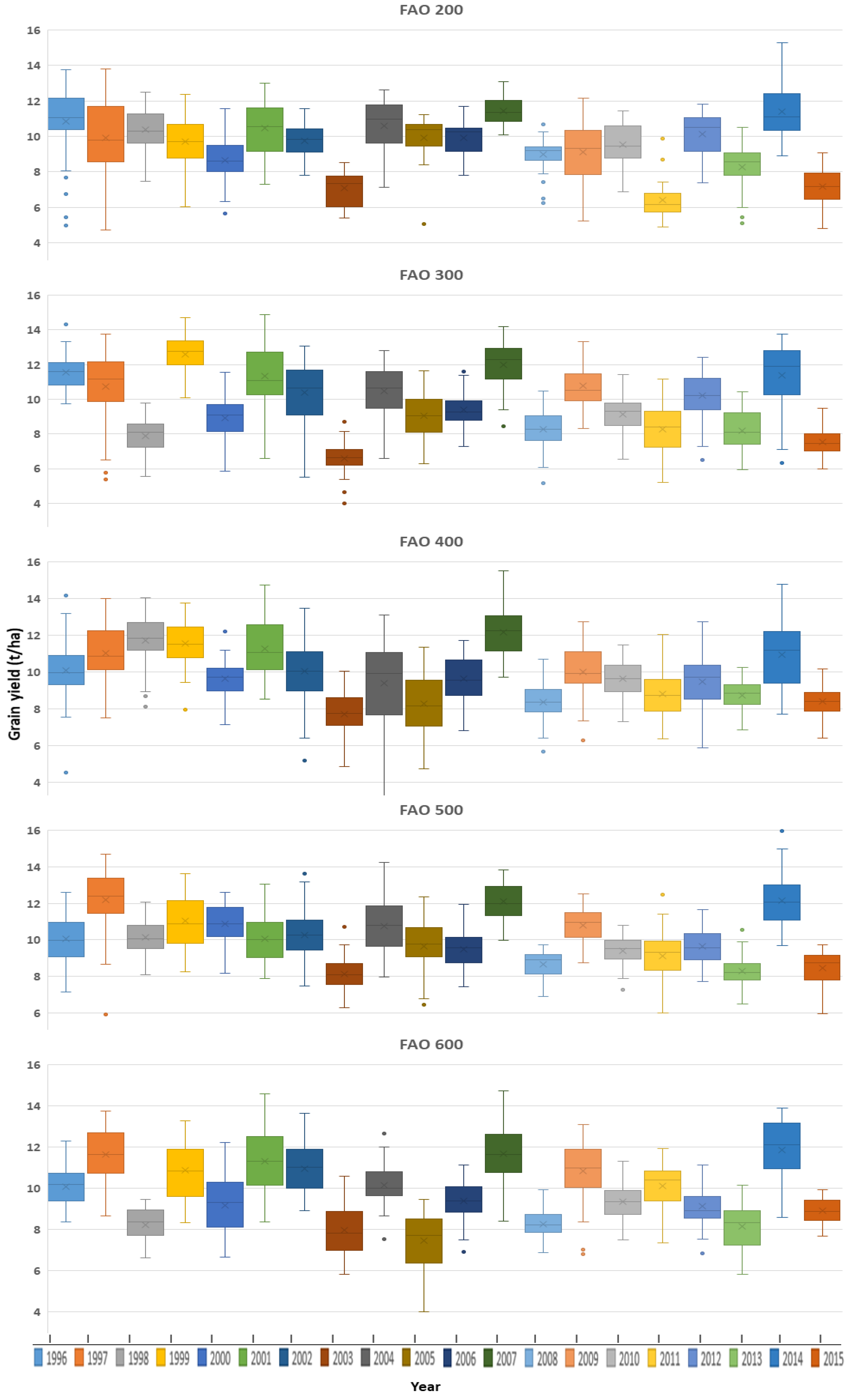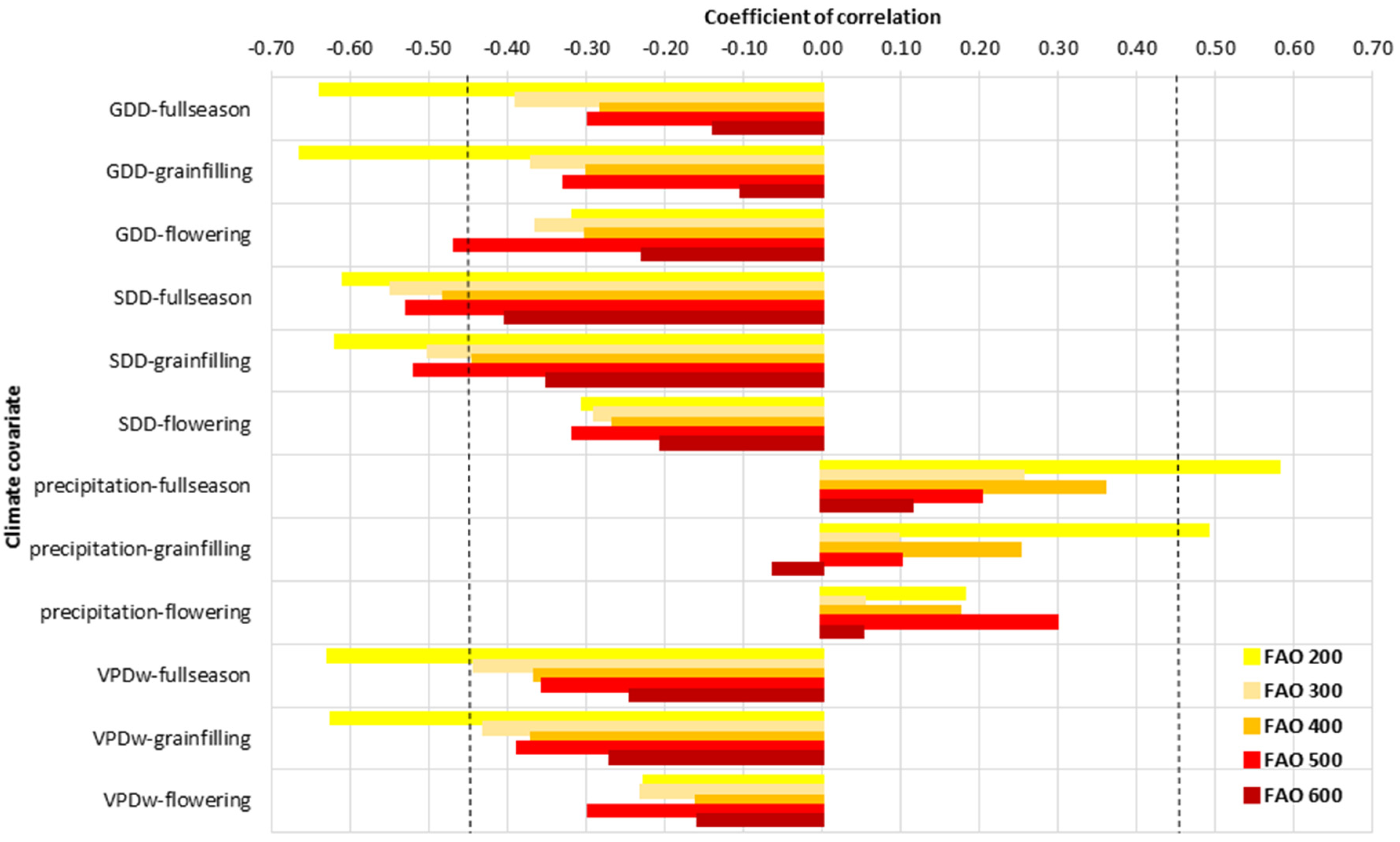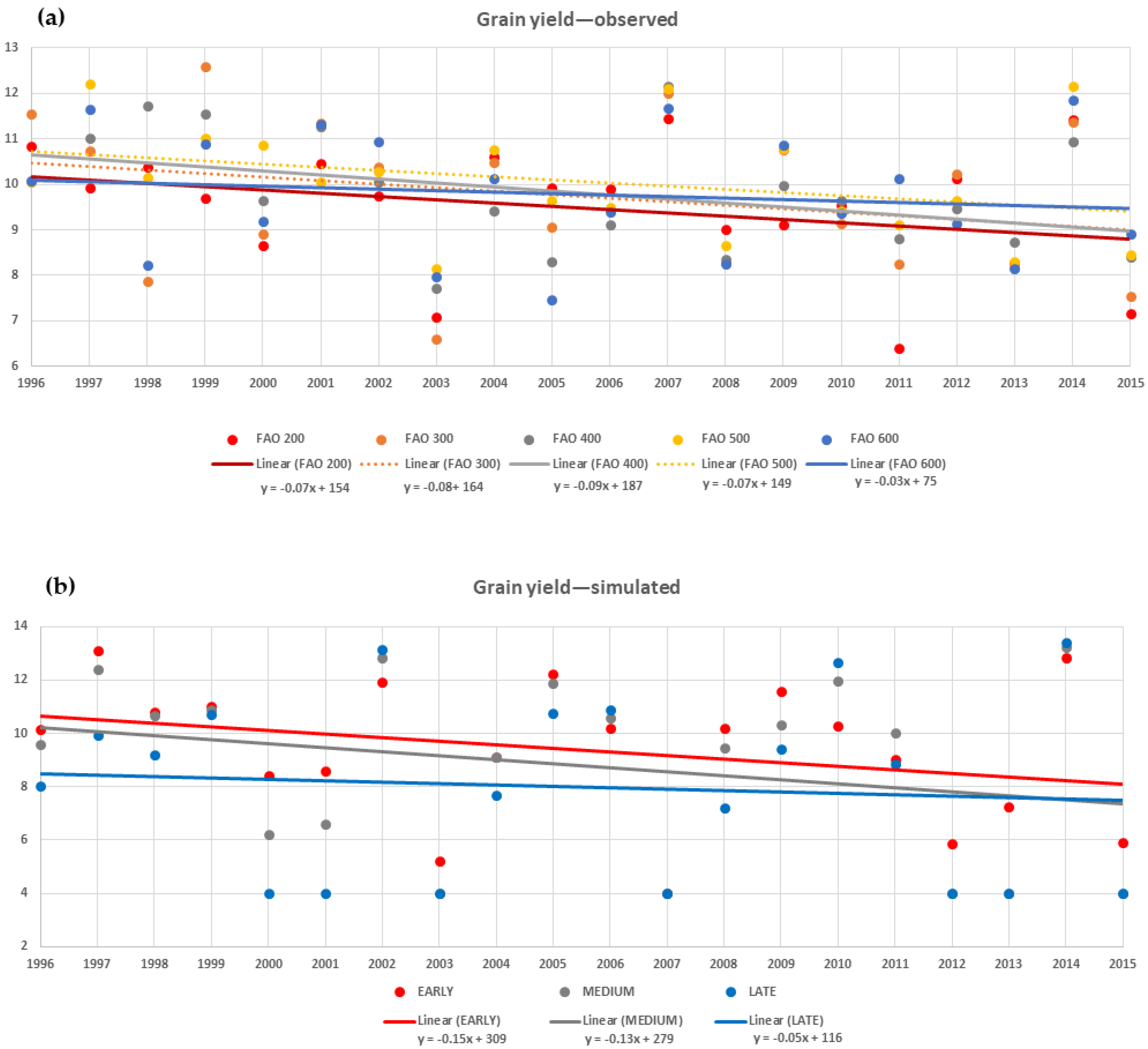Trends in Maize Grain Yields across Five Maturity Groups in a Long-Term Experiment with Changing Genotypes
Abstract
:1. Introduction
2. Materials and Methods
- (a)
- (b)
- Using vapor pressure deficit (VPD) calculated as weighted VPD (VPDw) [24], wherebywhere the vapor pressures VPmax and VPmin are medians calculated from measurements of the respective daily maximum and minimum temperaturesVPmax or VPmin = 0.6107 × exp(17.269 × T/(237.3 + T)).
3. Results
4. Discussion
5. Conclusions
Supplementary Materials
Author Contributions
Funding
Data Availability Statement
Conflicts of Interest
References
- Baum, M.E.; Archontoulis, S.V.; Licht, M.A. Planting date, hybrid maturity, and weather effects on maize yield and crop stage. Agron. J. 2019, 111, 303–313. [Google Scholar] [CrossRef] [Green Version]
- Pachauri, R.K.; Allen, M.R.; Barros, V.R.; Broome, J.; Cramer, W.; Christ, R.; Church, J.A.; Clarke, L.; Dahe, Q.; Dasgupta, P.; et al. Climate Change 2014: Synthesis Report. Contribution of Working Groups I, II and III to the Fifth Assessment Report of the Intergovernmental Panel on Climate Change; IPCC: Geneva, Switzerland, 2014; p. 151. [Google Scholar]
- Lobell, D.B.; Field, C.B. Global scale climate-crop yield relationships and the impacts of recent warming. Environ. Res. Lett. 2007, 2, 014002. [Google Scholar] [CrossRef]
- Lobell, D.B.; Banziger, M.; Magorokosho, C.; Vivek, B. Nonlinear heat effects on African maize as evidenced by historical yield trials. Nat. Clim. Chang. 2011, 1, 42–45. [Google Scholar] [CrossRef]
- Lobell, D.B.; Roberts, M.J.; Schlenker, W.; Braun, N.; Little, B.B.; Rejesus, R.M.; Hammer, G.L. Greater sensitivity to drought accompanies maize yield increase in the U.S. Midwest. Science 2014, 344, 516–519. [Google Scholar] [CrossRef] [PubMed]
- Schlenker, W.; Roberts, M.J. Nonlinear temperature effects indicate severe damages to U.S. crop yields under climate change. Proc. Natl. Acad. Sci. USA 2009, 106, 15594–15598. [Google Scholar] [CrossRef] [Green Version]
- Ray, D.K.; West, P.C.; Clark, M.; Gerber, J.S.; Prishchepov, A.V.; Chatterjee, S. Climate change has likely already affected global food production. PLoS ONE 2019, 14, e0217148. [Google Scholar] [CrossRef] [PubMed]
- Lee, E.A.; Deen, W.; Hooyer, M.E.; Chambers, A.; Parkin, G.; Gordon, R.; Singh, A.K. Involvement of year-to-year variation in thermal time, solar radiation and soil available moisture in genotype-by-environment effects in maize. Crop Sci. 2016, 56, 2180–2192. [Google Scholar] [CrossRef]
- Signor, C.E.L.; Dousse, S.; Lorgeou, J.; Denis, J.B.; Bonhomme, R.; Carolo, P.; Charcosset, A. Interpretation of genotype× environment interactions for early maize hybrids over 12 years. Crop Sci. 2001, 41, 663–669. [Google Scholar] [CrossRef]
- Brown, D.M.; Bootsma, A. Crop Heat Units for Corn and Other Warm-Season Crops in Ontario; Ontario Ministry of Agriculture and Food: Toronto, ON, Canada, 1993. [Google Scholar]
- Wang, J.Y. A critique of the heat unit approach to plant response studies. Ecology 1960, 41, 785–790. [Google Scholar] [CrossRef]
- Dwyer, L.M.; Stewart, D.W.; Carrigan, L.; Ma, B.L.; Neave, P.; Balchin, D. Guidelines for comparisons among different maize maturity rating systems. Agron. J. 1999, 91, 946–949. [Google Scholar] [CrossRef]
- Jugenheimer, R.W. Corn Improvement, Seed Production and Uses, A Wiley-Interscience Publication; University of Illinois, John Wiley & Sons: New York, NY, USA, 1978. [Google Scholar]
- EC (European Community). Council Directive 2002/53/EC of 13 June 2002 on the common catalogue of varieties of agricultural plant species. Off. J. Eur. Commun. 2002, 45, L193. [Google Scholar]
- EC (European Commission). Common catalogue of varieties of agricultural plant species—Supplement 2020/1. Off. J. Eur. Commun. 2020, 63, C71. [Google Scholar]
- Parent, B.; Leclere, M.; Lacube, S.; Semenov, M.A.; Welcker, C.; Martre, P.; Tardieu, F. Maize yields over Europe may increase in spite of climate change, with an appropriate use of the genetic variability of flowering time. Proc. Natl. Acad. Sci. USA 2018, 115, 10642–10647. [Google Scholar] [CrossRef] [Green Version]
- Buhiniček, I.; Kaučić, D.; Kozić, Z.; Vragolović, A.; Gunjača, J.; Šarčević, H.; Jukić, M.; Stepinac, D. Stress heat units and grain yields of maize testcrosses during 20 years of breeding. In Proceedings of the Book of Abstracts of 52nd Croatian & 12th International Symposium on Agriculture, Dubrovnik, Croatia, 12–17 February 2017; p. 76. [Google Scholar]
- Idso, S.B.; Jackson, R.D.; Pinter, P.J., Jr.; Reginato, R.J.; Hatfield, J.L. Normalizing the stress-degree-day parameter for environmental variability. Agric. Meteorol. 1981, 24, 45–55. [Google Scholar] [CrossRef]
- Jones, P.G.; Thornton, P.K. The potential impacts of climate change on maize production in Africa and Latin America in 2055. Glob. Environ. Chang. 2003, 13, 51–59. [Google Scholar] [CrossRef]
- Lobell, D.B.; Hammer, G.L.; McLean, G.; Messina, C.; Roberts, M.J.; Schlenker, W. The critical role of extreme heat for maize production in the United States. Nat. Clim. Chang. 2013, 3, 497–501. [Google Scholar] [CrossRef]
- Millet, E.J.; Welcker, C.; Kruijer, W.; Negro, S.; Coupel-Ledru, A.; Nicolas, S.D.; Laborde, J.; Bauland, C.; Praud, S.; Ranc, N.; et al. Genome-wide analysis of yield in Europe: Allelic effects vary with drought and heat scenarios. Plant Physiol. 2016, 172, 749–764. [Google Scholar] [CrossRef]
- Galić, V.; Franić, M.; Jambrović, A.; Ledenčan, T.; Brkić, A.; Zdunić, Z.; Šimić, D. Genetic correlations between photosynthetic and yield performance in maize are different under two heat scenarios during flowering. Front. Plant Sci. 2019, 10, 566. [Google Scholar] [CrossRef] [PubMed]
- Zhu, P.; Zhuang, Q.; Archontoulis, S.V.; Bernacchi, C.; Müller, C. Dissecting the nonlinear response of maize yield to high temperature stress with model-data integration. Glob. Chang. Biol. 2019, 25, 2470–2484. [Google Scholar] [CrossRef] [PubMed]
- Tanner, C.B.; Sinclair, T.R. Efficient water use in crop production: Research or research? In Limitations to Efficient Water Use in Crop Production; Taylor, H.M., Jordan, W.R., Sinclair, T.R., Eds.; ASA CSSA and SSSA: Madison, WI, USA, 1983; pp. 1–27. [Google Scholar]
- AGRI4CAST Resources Portal. Available online: https://agri4cast.jrc.ec.europa.eu/DataPortal/Index.aspx (accessed on 2 May 2021).
- Holzworth, D.P.; Huth, N.I.; Devoil, P.G.; Zurcher, E.; Herrmann, N.; McLean, G.; Chenu, K.; van Oosterom, E.J.; Snow, V.; Murphy, C.; et al. APSIM–evolution towards a new generation of agricultural systems simulation. Environ. Model. Softw. 2014, 62, 327–350. [Google Scholar] [CrossRef]
- Costa-Filho, E.; Chávez, J.L.; Comas, L. Determining maize water stress through a remote sensing-based surface energy balance approach. Irrig. Sci. 2020, 38, 1–18. [Google Scholar] [CrossRef]
- Tao, F.; Yokozawa, M.; Liu, J.; Zhang, Z. Climate-crop yield relationships at provincial scales in China and the impacts of recent climate trends. Clim. Res. 2008, 38, 83–94. [Google Scholar] [CrossRef]
- Sakurai, G.; Iizumi, T.; Yokozawa, M. Varying temporal and spatial effects of climate on maize and soybean affect yield prediction. Clim. Res. 2011, 49, 143–154. [Google Scholar] [CrossRef] [Green Version]
- Zorić, M.; Gunjača, J.; Šimić, D. Genotypic and environmental variability of yield from seven different crops in Croatian official variety trials and comparison with on-farm trends. J. Agric. Sci. 2017, 155, 804–811. [Google Scholar] [CrossRef] [Green Version]
- Butler, E.E.; Huybers, P. Adaptation of US maize to temperature variations. Nat. Clim. Chang. 2013, 3, 68–72. [Google Scholar] [CrossRef]
- Moore, F.C.; Lobell, D.B. Adaptation potential of European agriculture in response to climate change. Nat. Clim. Chang. 2014, 4, 610–614. [Google Scholar] [CrossRef]
- Caubel, J.; de Cortazar-Atauri, I.G.; Vivant, A.C.; Launay, M.; de Noblet-Ducoudré, N. Assessing future meteorological stresses for grain maize in France. Agric. Syst. 2018, 159, 237–247. [Google Scholar] [CrossRef]
- Liu, Z.; Yang, X.; Chen, F.; Wang, E. The effects of past climate change on the northern limits of maize planting in Northeast China. Clim. Chang. 2013, 117, 891–902. [Google Scholar] [CrossRef]
- Mitrović, B.; Stojaković, M.; Zorić, M.; Stanisavljević, D.; Bekavac, G.; Nastasić, A.; Mladenov, V. Genetic gains in grain yield, morphological traits and yield stability of middle-late maize hybrids released in Serbia between 1978 and 2011. Euphytica 2016, 211, 321–330. [Google Scholar] [CrossRef]
- Lyon, D.J.; Hammer, G.L.; McLean, G.B.; Blumenthal, J.M. Simulation supplements field studies to determine no-till dryland corn population recommendations for semiarid western Nebraska. Agron. J. 2003, 95, 884–891. [Google Scholar] [CrossRef] [Green Version]
- Tokatlidis, I.S. Adapting maize crop to climate change. Agron. Sustain. Dev. 2013, 33, 63–79. [Google Scholar] [CrossRef] [Green Version]
- Djaman, K.; Owen, C.; West Margaret, M.; Allen, S.; Koudahe, K.; Darapuneni, M.; O’Neill, M. Relationship between relative maturity and grain yield of maize (Zea mays L.) hybrids in northwest New Mexico for the 2003–2019 period. Agriculture 2020, 10, 290. [Google Scholar] [CrossRef]
- Lindsey, A.J.; Minyo, R.; Geyer, A.B.; Thomison, P.R. Comparing the agronomic performance of short-season and commonly grown corn hybrid maturities in Ohio. Crop Forage Turfgrass Manag. 2020, 6, e20019. [Google Scholar] [CrossRef] [Green Version]
- Marton, L.C.; Árendás, T.; Bónis, P. Grain Moisture of Maize Hybrids in Different Maturity Groups at Various Harvesting Dates. Acta Agrar. Debreceniensis 2003, 24–25. [Google Scholar] [CrossRef] [PubMed]



| FAO Group | Term | Estimate | SE | t | p |
|---|---|---|---|---|---|
| 200 | Intercept | 10.632 | 0.434 | 24.483 | <0.001 |
| Slope | −0.035 | 0.011 | −3.247 | 0.004 | |
| 300 | Intercept | 10.965 | 0.543 | 20.178 | <0.001 |
| Slope | −0.037 | 0.013 | −2.781 | 0.012 | |
| 400 | Intercept | 10.651 | 0.441 | 24.166 | <0.001 |
| Slope | −0.025 | 0.011 | −2.325 | 0.032 | |
| 500 | Intercept | 10.952 | 0.415 | 26.415 | <0.001 |
| Slope | −0.027 | 0.010 | −2.638 | 0.017 | |
| 600 | Intercept | 10.530 | 0.495 | 21.259 | <0.001 |
| Slope | −0.023 | 0.012 | −1.861 | 0.079 |
Publisher’s Note: MDPI stays neutral with regard to jurisdictional claims in published maps and institutional affiliations. |
© 2021 by the authors. Licensee MDPI, Basel, Switzerland. This article is an open access article distributed under the terms and conditions of the Creative Commons Attribution (CC BY) license (https://creativecommons.org/licenses/by/4.0/).
Share and Cite
Buhiniček, I.; Kaučić, D.; Kozić, Z.; Jukić, M.; Gunjača, J.; Šarčević, H.; Stepinac, D.; Šimić, D. Trends in Maize Grain Yields across Five Maturity Groups in a Long-Term Experiment with Changing Genotypes. Agriculture 2021, 11, 887. https://doi.org/10.3390/agriculture11090887
Buhiniček I, Kaučić D, Kozić Z, Jukić M, Gunjača J, Šarčević H, Stepinac D, Šimić D. Trends in Maize Grain Yields across Five Maturity Groups in a Long-Term Experiment with Changing Genotypes. Agriculture. 2021; 11(9):887. https://doi.org/10.3390/agriculture11090887
Chicago/Turabian StyleBuhiniček, Ivica, Dražen Kaučić, Zdravko Kozić, Mirko Jukić, Jerko Gunjača, Hrvoje Šarčević, Domagoj Stepinac, and Domagoj Šimić. 2021. "Trends in Maize Grain Yields across Five Maturity Groups in a Long-Term Experiment with Changing Genotypes" Agriculture 11, no. 9: 887. https://doi.org/10.3390/agriculture11090887






